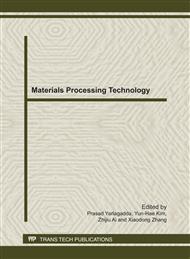p.701
p.705
p.709
p.713
p.719
p.724
p.728
p.735
p.739
Influence of Microstructure of TC11 Titanium Alloy on Ultrasonic Velocity and Attenuation
Abstract:
TC11 titanium alloy (Ti-6Al-3Mo-1.2Zr-0.3Si) was subjected to solution treatment above β-phase field solution for 1 h with different cooling rates, such as water quenching, oil quenching, air cooling and furnace cooling, and gained four different microstructures. The relationship between microstructures and ultrasonic parameters such as ultrasonic longitudinal wave velocities (ν) and attenuation coefficients (α) was investigated. The results show that ultrasonic longitudinal velocities and attenuation coefficients increase with reducing the cooling rate from water quenching to furnace cooling. The hardness of these microstructures exhibits an opposite behavior to longitudinal wave velocity and ultrasonic attenuation coefficient.
Info:
Periodical:
Pages:
719-723
Citation:
Online since:
September 2011
Authors:
Price:
Сopyright:
© 2011 Trans Tech Publications Ltd. All Rights Reserved
Share:
Citation:


